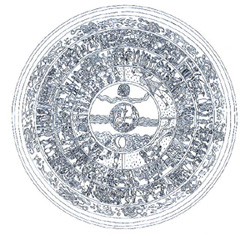 |
The Greek Age of Bronze
Iliad Shields |
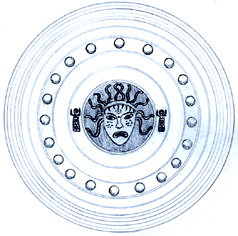 |
In the Iliad mostly of the Achaeans and Trojans shields are generically described as circular and made of several layers of ox-hide sometime reinforced with metal elements. Three words are used by Homer to describe shields: aspis, sakos, and rhinos(*1), these words seem not specificaly dedicated to the size or shape of a particular shield.
In few cases more elaborate shields are descibed as well as possible indications of body-shields are given. Based on these elements an hypothetical recontruction of some of these shields described in the Iliad can be made.
The Iliad's hexameter analysis, and some elements and places described in it, have demonstrated how the poem had its origins in the Mycenaean time (*2) (see also the page dedicated to the Trojan war) thus for all the reconstructions on this page, archaeological elements and art representations coming from the Late Helladic period have been reasonably used. |
The reconstruction of Achilles' shield is based on the hypothesis made by Peter Connolly (*3) and the detailed research by Dr. Raffaele D'Amato in his booklet includes in the metal figurines kit (*4).
Because such a shield as Achilles' has not been found does not mean it never physically existed. In fact, the physical existence of such similarly inlaid cups and swords and daggers are very real witnesses of Homer's knowledge. Furthermore the absence of much armor beyond swords and daggers among the many beautiful objects found in the excavations of Mycenaean dating is conspicuous, but understandable. Certainly shields are more useful for the living than for the dead.
The reconstructive hypotesis of this shield, forged by Hephaestus, was based on the Homer's description (Iliad XVIII, 478-607), and combining it with the example offered by the Bronze Age Aegean art. The shield was certainly embossed, but some details were in bronze, other in silver, others beaten and painted. It is also possible that some figures were in polychrome enamel.
The shield is compoused of 5 overlapped plates: two bronze, two tin and one gold (Iliad XX, 270-272) |
 |
The shield is divided in 5 areas:
First area: from the middle; Earth (who corresponds to the boss), Heaven, Ocean, Sun, full Moon.
Second area: Zodiac symbols, i.e. the Pleiads, Hyads, Orion, to which the Ursa or Vagon is turned.
Third area: two cities; in the first town wedding and banquets scenes, brides represented on bridal beds are led throughout the city flanked by torch-bearers; among them young dancers and flute and lyre players; other women are looking at it on their doors. In the main square of the town some people, held back by guards, assist boldly to a quarrel between two angry men, they have elders as judges, who are seated on polished stones in a holy circle, with the scepter in a hand; in the middle of the circle there are two golden talents.The second city is laid inder siege by two bronze covered armies, whose leaders are discussing; in the meanwhile a part of townsmen defends the civilians on the walls, another part takes up arms for ambushing and leaves the city leaded by armed Pallas Athena and Ares, gold covered, armed and bigger than the other characters; the army arrives at river preparing the ambush, with two spies at head; herds and oxen arrive together with two flute playing shepperds; these last are killed and the herds are scattered; the besiegers arrive on the horse-back and the battle breaks out on the river's banks; they fight with spears and there is a tremendous melee, mess and slaughter.
Fourth area: A three ploughing field and a fallow land on which the ploughmen are pushing the yoked oxen, in the meanwhile a man offers a cup of wine to the last ploughman; the ploughed land is made of gold; then there is an other royal field on the ground, part of it is clasped from three men with straw cords; behind it children glean passing the tufts, the king, on the furrow, looks and enjoys it with the scepter at hand. The royal pages are cooking the metal under an oak-tree, killing and preparing a big ox; women are shedding white flour. Then follows a golden vineyard rich of black painted bunches of grapes hanging from silver stakes and surrounded by an enamel ditch and a tin hedge; on the path towards the vineyard there are harvesting men, children and boys, with a lyre player in the middle, carring the grapes in wicker baskets, are dancing and skipping, a herd of tin and golden straight horned cows goes from the cowsherd to the grazing along the river and cane-brakes, they are joined by 4 shepperds and 19 dogs, some of them are barking before two lions which are yet eating the black-painted entrails of a bellowing bull before the cattle; then a big valley with herds, stables, hunts and sheds; then a dancing spectacle where boys and girls are holding their wrists; the girls are covered by voiles and are crowned, the boys have got very fine tunic, with golden swords, silver belts and oil-polished bodies, the legs are sometimes parallel, sometimes opposed. All around a crowd is looking, two acrobats are wheeling in the middle of it.
Fifth area: what is called by Homer "Father Ocean" |
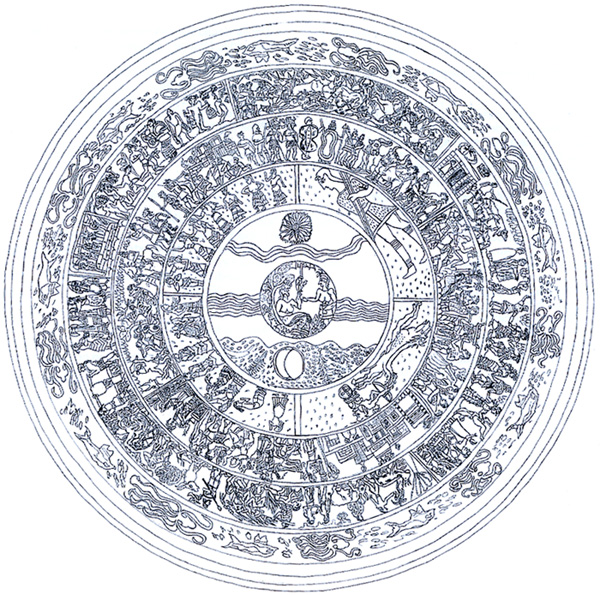 |
The following 78 elements, offered by Achaean art, have been used by Dr. Raffaele D'Amato for his hypothetical but reasonable reconstruction of the Achilles' shield:
1)Hunting dogs fresco from Tyrins XIII century BC, 2)Achaean woman fresco from Tyrins XIII century BC, 3)Women on chariot fresco from Tyrins XIII century BC, 4)priestess in front of a temple fresco from Mycenae Megaron XIII century BC, 5)Large gold ring from Mycenae XVI century BC, 6)Large gold ring from Tyrins XV century BC, 7)Krater fragment from Tyrins XIII century BC, 8)Warrior vase from Myceane XIII century BC, 9)Dagger from Mycenae XIV century BC, 10)Gold ring from Mycenae XVI century BC, 11)Vaphiò cup 1400 BC, 12)Gold cup from Midea-Dendra with sealife scene XV century BC, 13)Decorated vase with sea scene from Mycenae XIII century BC, 14)Silver rhiton with siege scene from Mycenae XVI century BC, 15)Gold ring with war scene from Mycenae XVI century BC 16)Gold ornament in shape of palace-temple from Mycenae XVI century BC, 17Gold ring from Mycenae XV century BC, 18)Fresco with ritual sacrifice from Hagia Triada Crete 1400 BC, 19)Tablet with war goddess from Mycenae 1250 BC, 20)Frescoes from Mycenae XIII century BC, 21)Fresco with warriors from Tyrins XIII century BC, 22)Fresco with man, horse and dog from Tyrins XIII century BC, 23)Fresco with lyre player from Pylos XIII century BC, 24)Tomb stele from Mycenae XVI century BC, 25)Ivory warrior's head from Mycenae XIII century BC, 26)Gold seal from Mycenae XVI century BC, 27)Gold ring from Tyrins XIV-XIII century BC, 28)Fresco with warriors and battle scene from Pylos XIII century BC, 29)Frescoes from Pylos XIII century BC, 30Frescoes from Pylos XIII century BC, 31Fresco with war chariot and horse from Pylos XIII century BC, 32)Fresco with couple on chariot from Hagia Triada XIV century BC, 33)Hunter figure from Tyrins XIII century BC, 34)Fresco of warrior on battle from Tyrins XIII century BC, 35)Fresco with scene of battle from Pylos XIII century BC, 36)Fresco with war scene from Pylos XIII century BC, 37)Silver decorate cup from Mycenae XIII century BC, 38)Fresco with hunter from Pylos XIII century BC, 39)Fresco with hunter from Pylos XIII century BC, 40)Fresco with man from Pylos XIII century BC, 41)Fresco with female figure from Thebes 1375 BC, 42)Ivory mirror handle from Enkomi XII century BC, 43)Fresco with banquet and servers from Knossos XVI century BC, 44)Glass from Haghia Triada XV century BC, 45)Fresco with crocus gatherers from Creta 1600 BC, 46)Ivory elements in shape of delphin from the "house of shields" in Mycenae XIII century BC, 47)Fresco with young boxer from Akrotiri Thera 1600 BC, 48)Big fresco from Akrotiri Thera 1600 BC, 49)Fresco with young women from Pylos XIII century BC, 50)Fresco with preparatory for the battle from Mycenae XIII century BC, 51)Fresco with hunt dogs from Pylos XIII century BC, 52)Vase with figures of harvesters from Hagia Triada 1500 BC, 53)Figure of prince on gemstone XIII century BC, 54)Stele with lions and bull from Mycenae XVI century BC, 55)Fresco with fisherman from Thera 1600 BC, 56)Amethyst seal from Mycenae XV century BC, 57)Ivory representation of bull hunting from Katsamba Crete XV century BC, 58)Fresco with young runners from Knossos XVI century BC, 59)Fresco with women from Knossos XVI century BC, 60)Rhyton with games scene from Hagia Triada XVI century BC, 61)Gold ring from Fourni Crete XVI century BC, 62)Fresco with bearers from Knossos XVI century BC, 63)Rings with gold seal from Mycenae XVI century BC, 64)Fresco with warrior from Tyrins XIII century BC, 65)Seal with minoan warrior XVII century BC, 66)Seals with warrior and archers from Thebes XVI century BC, 67)Linen fragment painted with war scene from Mycenae XII century BC, 68)Bronze and gold ring from Mycenae XIV century BC, 69)Vase for food from Kition Cyprus XIII century BC, 70)Late mycenaean bronze statuette XII century BC, 71)Ivory sculpture of achaean warrior XIII century BC, 72)Fresco with warrior from Pylos XIII century BC, 73)Seal stone with Hippos god from Knossos XIII century BC, 74)Achaean sword handgrip from Mycenae XVI century BC, 75)Gold and copper seal with women from Mycenae and Crete XVI-XV century BC, 76)Fresco with crocus gatherers from Akrotiri Thera 1600 BC, 77)Fresco with three young women from Akrotiri Thera 1600 BC, 78)Male statuette from Petsofa Creta XVIII century BC. |
| This shield has been excellently sculptured by Adriano Laruccia in the metal figurine kit "HECTOR AND ACHILLES" by SOLDIER. |
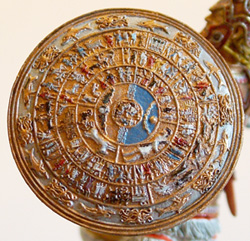 |
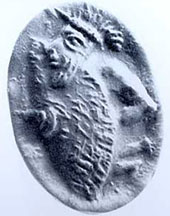 |
A possible evidence of an Aegean/Anatolian late bronze age shield with relief decorations on the external surface is from a domed seal from Enkomi Cyprus, dated around 1190-1180 BC. Even if this shield has been generaly interpreted as made of wickers structure, we can't exclude the possibility that its external surface was made of a metal sheet with relief decorations as attested in the Iliad description. . |
| The Archaic Greek tradition of decorating shields and bowls with various scene such as this shield from Crete dated around VIII century BC, takes probably reference from the bards description of Achaean shields such the one of Achilles. |
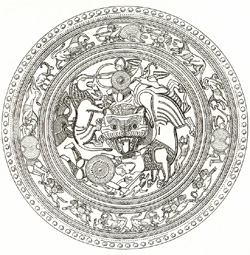 |
| A further detail about the Achilles' shield is that it had a silver shoulder belt. (Il. XII, 480)
|
| which should means that the leather strap passing through the body and supporting the shield was covered with a thin sheet of silver, similar to the gold sword's shoulder belts found in Mycenae (see also the page dedicae to the swords) or that this leather strap was decorated with silver nails. |
| The Agamemnon' s shield is big and intricately decorated because it is said that he took up the man-enclosing elaborate stark shield, a thing of splendour. There were ten cirles of bronze upon it, and set about it were twenty bosses of tin, pale-shining, and in the centre, another boss of dark cobalt. And cirled in the midst of all was the blank-eyed face of the Gorgon with her stare of horror, and Deimos (the Fear) and Phobos (the Terror) were inscribed upon it (or near it). (Il. XI, 32-37) |
| The shield had a strap with silver upon it, and there also on it was coild a cobalt snake, and there were three heads upon it twisted to look backwards and all three grown from a single neck. (Il. XI, 38-40) |
| Even if we can't exclude that Agamemnon was bearing a body-shield, its description lets us imagine more likely his shield as a large round one big enough to enclose most of the warrior's body. This shield could be similar to the ones shown on the backside of the famous warriors vase from Mycenae. |
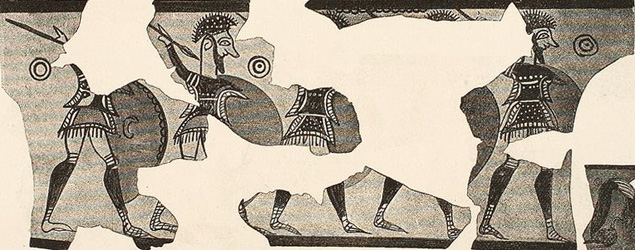 |
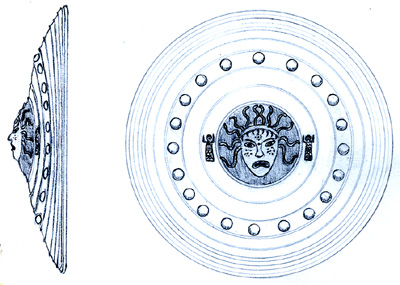 |
Based on the above mentioned elements the reconstruction of the Agamemnon's shield can be imagine as a large round shield covered with a bronze plate shaped in ten concentic circles. Twenty tin bosses are placed in the center of the shield with a big boss painted in black in the very center. Upon it the image of a Mycenaean style Gorgon based on the female head in painted plaster from Mycenae. On the sides of the Gorgon there are Deimos and Phobos based on Mycenaean goddess statuetes.
Also in this case the figures were more likely in policrome enamel. |
| This shield has been excellently sculptured by Adriano Laruccia in the metal figurine kit "AGAMENON Rey de Micenas y de Argos " by ART GIRONA. |
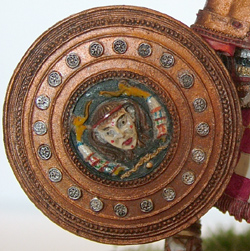 |
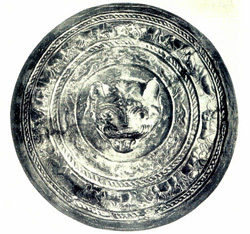 |
An Archaic shield from Crete dated around VIII century BC, with the cental boss shaped into the form of an animal head recalls the images of the Agamemnon's shield which is described with several circles of bronze and the Gorgon embellishing the centre of the shield. |
| The shield of Ajax son of Telamon is well described with several detail in the Iliad. It is made by Tikios from Ile with seven layers of ox-hide with an external bronze plate (Il. VII, 220-223) and (Il. VII, 245-246) |
For this shield no precise indications about its shape are given but it is not described as round or perfect circle or equally balanced as for mostly of the other Achaeans and Trojans shields. Indeed a possible indication that this shield is probably a huge body-shield(*5) can be guessed by the figurative images of Ajax who is always described as bearing his shield like a wall or tower or bastion.
(Il. VII, 219), (Il. XI, 485), (Il. XVII, 128) |
 |
Even if Ajax is sometime metaphorical described as bulwark of the Achaeans(*6) and the word pyrgon (tower, bastion, wall) is also used in figurative way to indicate columns, ranks or mass (Il. IV, 334) "...mass of Achaeans advancing..." (Il. IV, 347) "...ten ranks of Achaeans...". Referring to Ajax this word is only used when he is bearing and he is moving with his shield (so it would be very inappropriate to compare him with a immovable tower or wall). Based on these elements any huge shield (more likely body-shield) could be applicable to Ajax even if in our opinion the rectangular body-shield gives a much more figurative image of a "beared shield like a wall or tower" respect to the one in figure of eight or a proto-Dipylon one and even more respect to a simple large round shield.
Anyway because the word "wall" or "tower" is not strictly related to the shape of the shield different hypothesis can be considered like for instance the one made by the reenactor and researcher in ancient weaponry Don Howard on his book(*7). |
| A further indication that the shield of Ajax was not a simple common round shield thus with an easy recognizable shape (the tower shield even if still used in a period compatible with the Trojan war -as attested in a pottery fragment from Tyrins it was certanly less common during the final phase of the Late Helladic) is given when Cebriones recognize Ajax because his huge shield beared on the shoulders (Il. XI, 526-527) |
| It seems that Ajax sometime keeps his shield on ground (like a barricade or a wall or a tower) because Teucros is hiding behind the Ajax's shield, when Ajax moves the shield he throws the arrow....than he comes back to Ajax who protect him behind the marvelous shield (Il. VIII, 268-272). This is also another indication that very likely the Ajax's shield was not a normal round shield |
| The shield of Ajax is very heavy because hardened combat veterans followed the Great , ready to take his shield whenever sweat and labor sapped his limbs. (Il. XIII, 709-711) |
| Another possible indication of the huge size of Ajax's shield is given by Achilles when he declared that he couldn't fits in any weaponry except for the shield of Ajax (Il. XVIII, 192-193) |
 |
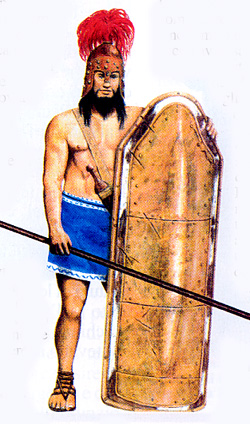 |
This is an interesting reconstruction of a big Achaean warrior with a rectangular body-shield made of ox-hide and reinforced with a bronze plate. As above mentioned even if no exact references are given about the shape of Ajax's shield this representation is fully reasonable and fits well with the figurative image of Ajax as given in the Iliad "Ajax came up bearing his shield in front of him like a wall" or "Now Ajax came near him, carrying like a wall his shield".
The representation of the Ajax's shield like a body shield in shape of tower is also fully compatible (much more than any other kind of shield) with the above mentioned Iliad indications:
1) The shield is not described having a round shape (like mostly of the other Achaean and Trojan shields)
2)The shield had an easy recognizable shape (thus a less common shape respect the other typic round shields of the same period)
3)The shield was also used on ground as a protective barricade
4)The shield was very heavy even for a strong and huge warrior like Ajax
5)The shield was huge being the only weponry which could fit with another "big" warrior like Achilles.
Furthermore the metaphorical and figurative image of Ajax moving and bearing like a tower or wall his shield it is much more appropriate an logical with a huge rectangular shield than with a normal round shield.
Based on these indications it is fully reasonably to guess that the Ajax's shield was probably different from mostly of the other shields described in the Iliad. |
It has been sometime argued that a such big shield made of seven layers of ox-hide and a large bronze plate would be too heavy to be wield in combat. As already mentioned in the page dedicate to the body-shield if we consider that the average density of bronze is 8300 Kg/m3, a plate for a body-shield in shape of tower approximately of 1.65 m (about 5 feet) by 1 m (about 3 feet) with a thickness of 0.3 mm(*8) would increase the weight of the shield of about 4 Kg.
Assuming that a thin layer of ox-hide of the same dimensions weight about 2 Kg and that such big shields could have been made of concentric layers of hide with the dimension of each layer smaller than the one bellow it in order to reduce the weight of the shield while maintaining a good protection in the center, where the warrior has more risk to get injured in case the shield is damaged. The total weight of the seven ox-hide would be no more than 6 Kg plus the 4 Kg of the bronze plate we have a total weight of the shield around 10 Kg a reasonably wielded weight for a huge and heroic strenght warrior like Ajax even if, as attested in the Iliad, this huge shield was sometime very heavy also for him.
|
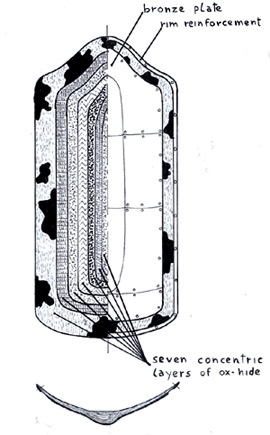 |
| At least one occasion Hector was bearing a body-shield because Homer says that both his ankles and his neck clashed the dark hide, the rim running round the edge of the bossed shield. (Il. VI, 117-118) |
Also in this case there are no precise indications about the shape of the shield even if the presence of a boss could be a possible indication of a body-shield in figure of eight or more likely a proto-Dipylon one (see the page dedicated to the body-shield).
Indeed, even if there is nothing to suggest that Homer was refering to the same type of shield, there are four other occasions where Hector's shield is described as circular or equally balanced (Il.III, 356) and (Il. VII, 250), (Il. XI, 61), (Il. XIII, 157) |
 |
 |
 |
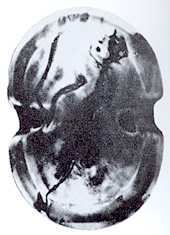 |
If we accept the idea that Hector was alway bearing the same shield, it was for sure neither the rectangular and probably nor the one in figure of eight being these types not round or equally balanced. The only archaeological based body-shield which could correspond to this description it is the one identified as proto-Dipylon which was basically a round or oval shield (sometimes bended on sides) with two lateral scalops for its better utilization during the fighting with sword or spear(*9). This shield, even if often confused with the one in figure of eight, has been used in all the Aegean Bronze Age and it was the only body-shield still used in the Geometric/Archaic time. |
| There are further detail of Hector's shield which was fortified with skins, and over was spreaded a lot of beaten bronze (Il. XIII 802-804) |
| As above mentioned the shield was described as bossed, but the ox-hide covered most of it because Hector says "...I knows as to move on the left and on the right the dryed ox-hide, my shield in the fight..." (Il. VII, 238-239) |
 |
Based on these elements the Hector's shield can be reasonably hypothesised as a circular body-shield (proto-Dipylon type) made of several layers of ox-hide, which cover most of it, with dark leather sewn all around the edge and a central bronze reinforcement. Furthermore this shield follows the more Anatolic version of the Achaean shield, even if much bigger, because its similarity with Hittite shield.
A beautifull representation of Hector's shield has been drawn by Giorgio Albertini for the booklet included in the figurune kit. In this painting Hector is shown during his fatale duel against Achilles.
We could also hypothize that the Hektor's body shield was just a huge full-height circular shield being these shields also used in later periods like in the Byzantine ships or in other culture. Experiments have demostrate that a such full-height circular shield (without any lateral cuts or bend) is impraticable in the close combact engagement with sword or spears (the typical fighting of the Homeric Heroes).
A full-height circular shield could be at least useful in formation fighting or, like in the Byzantine ships, almost as static barricate. Some experiments also show as a full-height circular shield was much more impraticable respect to body-shield in other shapes when beared on shoulder during running or chariot riding.
Furthermore there are no Late Helladic archaeological evidence that such full-height circular shield existed and were actually used by the Achaeans. All the possible representations of large shields (not necessarily full circular) even from a group of warriors in a possible proto-phalange formation as in the back side of the warrior's vase or in the stele from Mycenae, show shields with a maximun wide from the neck to just bellow the knees of the man.
Even if we accept the reasonable hypothesis that the full-height circular shield could have been also used by Late Helladic warriors these were very likely beared by low rank soldiers in proto-phalange formation fighting, but for sure (both based on Homer descriptions and experiments) not for the type of fighting of the Iliad elite warriors like Hektors, Agamemnon, Aeneas, Achilleus etc.... |
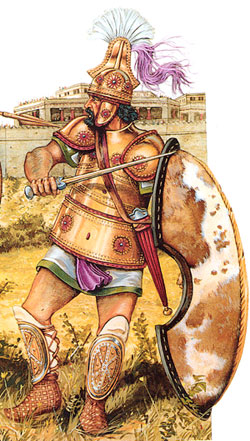 |
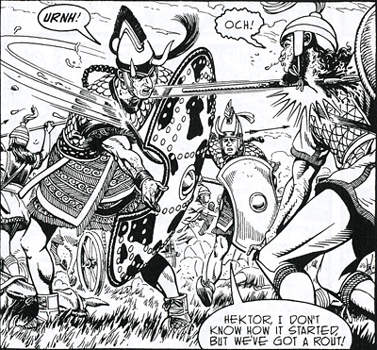 |
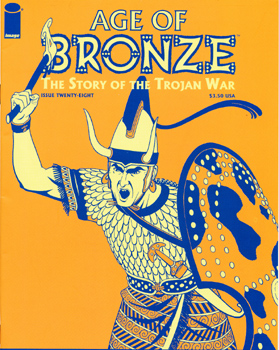 |
Another very interesting and fully reasonable interpretation of the Hector's shield has been made by by Eric Shanower on his awesome mithologically and archaeologically based comic serie AGE OF BRONZE THE STORY OF THE TROJAN WAR.
This is a body-shield (proto-Dipylon type) made of several layers of ox-hide, which cover most of it and over was spreaded a lot of beaten bronze. Also in this case the shield follows the more Anatolic version of the Achaean shield, because its similarity with Hittite shield.
It is also very interesting the Hector's outfit and general look represented as Anatolian/Hittite style |
IDOMENEUS: His shield is typical of those described in the Iliad being circular, made of multiple ox-hide and faced with bronze. For his shield we have some other detail because Homer says that it was fitted with double stays or bars. These are probably to be intended as the two handles used to hold the shield (*10) as also attested in a fresco from Pylos (see the page dedicated to the round shields)
(Il. XIII, 405-407) |
| SARPEDON: his shield was also circular facing the bronze and made of ox-hide in close folds with golden stitches(*11) round the circle (Il. XII, 294-297). In another passage (Il. XII 401-402) Sarpedon's shield is described as "man enclosing" like the one of Agamemnon and it is equipped with shoulder belt. |
| AENEAS: Like the shields of Agamemnon and Sarpedon also the Aeneas' shield is described circular and "man-enclosing". It is also said that his shield was constructed with layered circles of ox-hide and with a circle of bronze that were both thinner on the rim. This is a possible evidence of a shield constructed with concentric cirles of hide with the diameter of each layer smaller than the one below it. (Il. XX, 273-280) |
| TEUKROS: His shield was made of of four layers of hide. (Il. XV, 479) |
PERIPHETES: His shield was more likely a body-shield because he tripped over the rim of his shield which reached down to his feet as he turned to withdraw. Also in this case because no indication of shape are given he could had beared any kind of body-shield.
(Il. XV, 645-646) |
| NESTOR: His shield seems to be made of gold including the stay. It was probably a shield decorated with a gold plate on external surface and a gold grip. (Il. VIII, 192-193) |
| MENELAUS: Very few indications are given about his shield which is only described as circular (Il. III, 347), broad (Il. XIII, 608) and heavy enough to resist the spears of Paris (Il. III, 348) and Peisandros (Il. XIII, 607) |
| OTHER MYTHOLOGYCAL SHIELDS
|
Worthy to be mentioned are other shields beared by Mythologycal Heroes described by the poets of the Classical Greek period.
Of course mostly of the descriptions of these shields could be more related to the weaponry used during the classical time than the Mycenaean period. Indeed we can't completelly exclude that some elements could have hand down from the Bronze Age Heroic time. |
HERAKLES: The Herakles' shield is described in a short poem more likely compoused by a Greek poet lived between 590-555 BC. Even if the poem is generically ascribed to Hesiod. This opera is compoused by 480 exameter and it is relevant to the duel between Herakles and Cycnus son of Ares.
In the description of the shield several elements are mentioned: The white ivory, amber and gold (all around the external edge and for the warriors armour), adamas -a not well identified hard material more likely an iron alloy (for Phobos placed in the center) and silver (for the body of the heroes).
The scabbard of a sword, the blood and the grape are black, the harbour is in tin, other images like the fishes, the walls of the town and the shoulder-belt are in bronze. The Herakles' shield is decorated with ivory and amber two materials which can be damascene, these elements can be fixed in an adeguate seat of the bronze using glue or nails.
If this poetic description maintained a link with some real ancient shields this means that in these shields also the ivory and the amber could have been placed together the metal and probably also the lapis-lazuli well known bt the Mycenaeans.
For some scholars also the large shield found in the grave of Philip II of Macedon in Verghina made of wood, leather and with a decorated gold layer with ivory and blue glass stones could have been made taking into account the description of some high rank Mycenaean shield. |
| In the poem of the Seven against Thebes, Aeschylus (525-456 BC) describes the large shields of the Argives heroes. |
| TYDEUS: In the shield of Tydeus a sky full of stars with in the middle a full moon are present. |
| CAPANEUS: His shield is described with a naked man bearing the fire and the gold words "I'll burn the city" |
| ETEOCLES: He has a similar shield with phrases incribed on a landscape as well. |
| PHARTHENOPEUS: His shield has a Sphinx placed in the bronze with nails |
| POLYNEICES: His shield shows justice who leads a gold embossed warrior. |
| Even if mostly of these description are more likely based on images and representations present in the Clasical Greek pottery some metallurgical techniques and gold engraved decorations have similarity with some Bronze Age decorative objects and weaponry. |
(*2) JOACHIM LATACZ, Troy and Homer, Towards a solution of an old mystery OXFORD UNIVERSITY PRESS (2004).
|
(*3)PETER CONNOLLY The leggend of Odysseus OXFORD UNIVERSITY PRESS 1986.
|
(*4)Metal figurine from SOLDIER Hector and Achilles Archaeological Research by RAFFAELE D'AMATO sculpture by ADRIANO LARUCCIA
|
| (*5)The tradition that the Ajax's shield was a body-shield is attested in ancient Greece since the IV century BC where the artist normaly represented Ajax bearing a Dipylon or Boeotian shield being this body-shield the only one which has been memory related through the centuries.Henry Schliemann was the first to hypotize that the figurative images of "Ajax came up bearing his shield in front of him like a wall" given by Homer was more likely related to a warrior bearing a tower shape body-shield. |
(*7) Dan Howard, BRONZE AGE MILITARY EQUIPMENT; Pen & Sword 2011 .
|
(*8) The lightest European Bronze Age shield plates so far found in the archaeological record are about 0.3 mm thick.
|
(*9) The scalops and the bended sides do not necessarly required a different description respect to the one given by Homer also considering that the Iliad is not a "free rules" tale but a poem with verse written in hexameter lines.
|
(*10)These elements have been also interpreted as internal reinforcing stays. What seems to be a shield reinforced with stays is visible on a "Sea People" shield represented in the Medinet Habu relief, even if looking at the entire relief the two lines over the shield are only the ropes hanging from the ship's sail. (see also the page dedicated to the Sea People)
|
| (*11) In one of the "Warriors'greaves" from Haghios Joannis near Knossos dated around the middle of 15th century BC several fragment of metallic wire have been found. These wires could have been used to joint together the several layers of hide of a shield. |
|